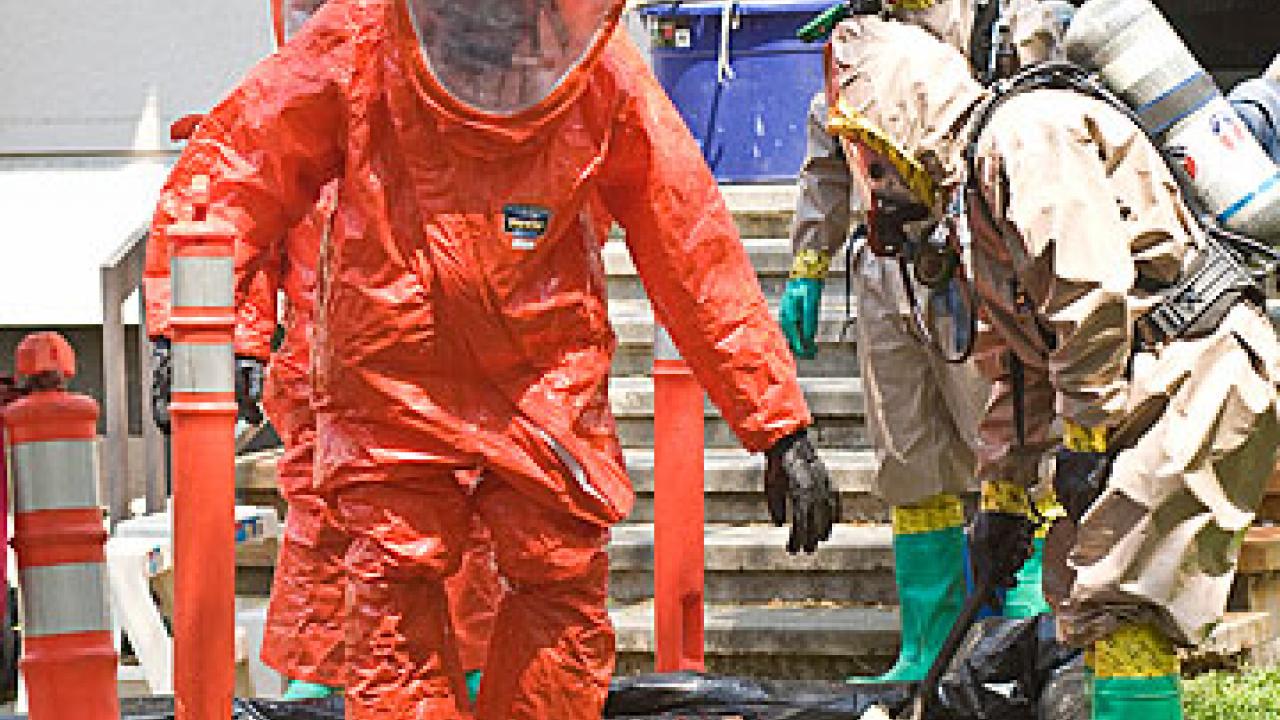UC Davis firefighters and other emergency personnel dealt quickly with a pair of chemical spills in university labs within the span of six days. No one was seriously hurt.
After the most recent spill, which occurred the morning of June 23 in 130 Chemistry Building, a doctoral student and a student affairs officer were taken by ambulance to the UC Davis Medical Center in Sacramento, where they were treated and released. The student got some of the hazardous chemical, nitrobenzene, on a wrist and forearm; the student affairs officer, working in a room next door, complained of eye irritation from the vapor.
After the other spill, the morning of June 17 in Hunt Hall, a staff researcher initially refused medical treatment. Later, he went to Sutter Davis Hospital, where he was treated and released.
Authorities evacuated both buildings. The spill in Hunt Hall did not affect classes because it happened during the week between the end of the spring quarter and the start of summer session. The spill in the Chemistry Building occurred on the first day of Summer Session I, forcing the relocation of 10 classes for that day only.
The nitrobenzene spill occurred at about 7:30 a.m. in Professor Philip Power's chemistry lab. The student dropped a glass jug and it broke on the floor, spilling close to 3 liters of the oily substance; it is used as a solvent in laboratory settings, and can cause illness if inhaled, absorbed through the skin or ingested.
The UC Davis Fire Department summoned its hazardous-materials partners -- fire crews from Davis, Woodland and West Sacramento -- and together they tackled the nitrobenzene spill. Two UC Davis firefighters entered the building; they wore protective suits for their job of inspecting the spill and containing it with absorbent material.
Woodland firefighters suited up, too, for the task of washing down the UC Davis firefighters when they emerged from the building. A catch basin kept the water from seeping into the ground or going into storm drains.
Authorities reopened the Chemistry Building, except for Room 130 and an adjacent duct shaft, by midafternoon.The campus's Environmental Health and Safety unit called in a contractor to clean up the spill, and the contractor had finished its work by midweek.
Still, the lab remained off-limits to researchers pending the monitoring of the level of nitrobenzene in the air.
"All of the individual fire units worked together seamlessly to make the response to the Chemistry Building spill go smoothly and efficiently," said Debbie Decker, an Environmental Health and Safety specialist.
She also credited UC Davis police and Transportation and Parking Services for aiding in the evacuation and for being indispensable in controlling traffic and spectators, "keeping people out of harm's way and out of the way of the fire folks."
The spill in Hunt Hall occurred at about 10:30 a.m. June 17 in Room 284, a plant sciences lab on the second floor. Authorities identified the chemical as mercaptoethanol, a reducing agent used to break disulfide bonds in proteins. It can be harmful if inhaled or spilled onto the skin and not treated.
The researcher dropped a glass bottle containing two to three cups of the liquid, and the bottle broke on the floor. The accident happened as the researcher removed the bottle from its protective wrapping.
The researcher put the broken bottle under a fume hood, placed absorbent pads over the spill on the floor, then left the building and called 911.
Firefighters cleared the two-story building (only half is in use, because the first floor is being renovated) and identified the spilled chemical, then inspected the lab and put more absorbent material on the spill. Officials elected to let the substance off-gas overnight -- with the building's ventilation system and the lab's fume hood sucking the vapor outdoors.
Authorities reopened all but the second floor's north wing, where the spill occurred, and, as the vapor dissipated, allowed people back in to all parts of the wing except Room 284. A day or two later, the lab's occupants cleaned up the spill.
On June 24, one week after the spill, Environmental Health and Safety specialists met with researchers, determined there was no residual chemical odor from the spill, and OK'd the lab for reoccupancy.
Media Resources
Dave Jones, Dateline, 530-752-6556, dljones@ucdavis.edu
